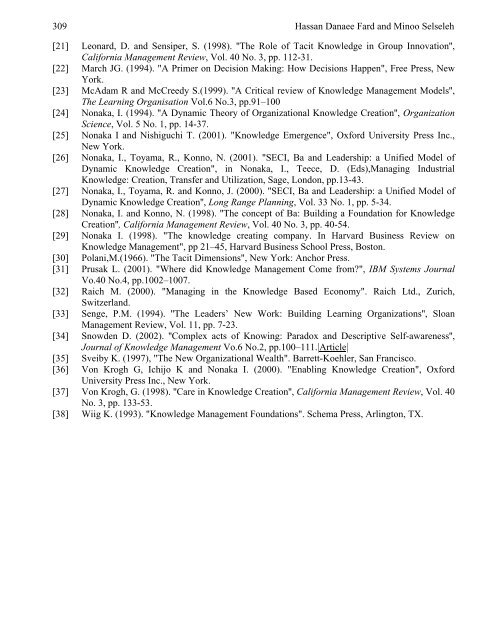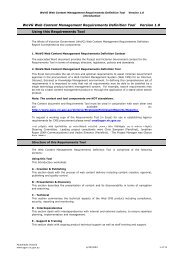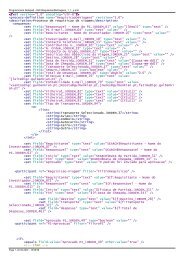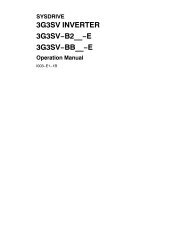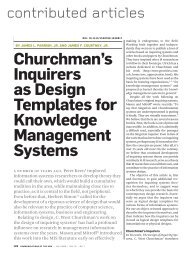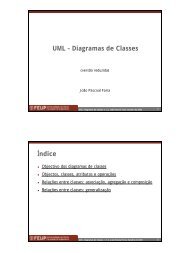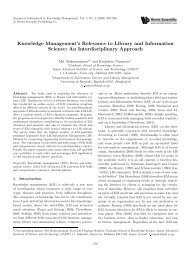<strong>Measuring</strong> <strong>Knowledge</strong> <strong>Management</strong> <strong>Cycle</strong>: <strong>Evidence</strong> <strong>from</strong> <strong>Iran</strong> 308cycle- creating, organizing, sharing, applying- should be taken into consideration together. In addition,proper policies should be designed in all loops in order for attracting knowledge-based employees.References[1] Alavi M and Leidner DE.(2001). ''<strong>Knowledge</strong> <strong>Management</strong> and <strong>Knowledge</strong> <strong>Management</strong>Systems: Conceptual Foundations and Research Issues'', MIS Quarterly, Vol. 25 No.1, pp. 107–136.[2] Becerra-Fernandez I, Gonzales A and Sabherwal R. (2004). "<strong>Knowledge</strong> <strong>Management</strong>:Challenges, Solutions, and Technologies", Pearson Education Inc., Upper Saddle River, NJ.[3] Conner, K.R. and Prahalad, C.K. (1996). '' Resource-based Theory of the Firm: <strong>Knowledge</strong>Versus Opportunism'', Organization Science, Vol. 7 No. 5, pp. 477-501.[4] Conner, K.R. (1991). ''A Historical Comparison of Resource-based Theory and Five Schools ofThought within Industrial Organization Economics: Do We have a new Theory of theFirm?'',Journal of <strong>Management</strong>, Vol. 17 No. 1, pp. 121-55.[5] Davenport, T.H. and Prusak, L. (1997). "Working <strong>Knowledge</strong>: How Organizations<strong>Management</strong> What they Know", Harvard Business School Press, Cambridge, MA.[6] Drucker, Peter.(1999)." The Post – Capitalist Society", Oxford: Butterworth-Heinemann.[7] Earl M. (2001). "<strong>Knowledge</strong> <strong>Management</strong> Strategies: Toward a Taxonomy", Journal of<strong>Management</strong> Information Systems Vol.18 No.1, pp.215–233.[8] Grant, R. (2001). “<strong>Knowledge</strong> and Organization”, in Nonaka, I. and Teece, D. (Ed.),"Managing Industrial <strong>Knowledge</strong>: Creation, Transfer and Utilization", Sage, London, pp. 145-69[9] Grant, R. (1997). ''The <strong>Knowledge</strong>-Based View of the Firm: Implications for <strong>Management</strong>Practice'',Long Range Planning, Vol. 30 No. 3, pp. 450-4.[10] Grant, R.M. (1996b). ''Toward a <strong>Knowledge</strong>-Based Theory of the Firm'', Strategic <strong>Management</strong>Journal, Vol. 17, pp. 109-22.[11] Grant, R.M. (1996a). ''Prospering in Dynamically-Competitive Environments: OrganizationalCapability as <strong>Knowledge</strong> Integration'', Organization Science, Vol. 7 No. 4, pp. 375-87.[12] Handzic M (2006). "Role of e-government in Rebuilding Bosnia-Herzegovina", InEncyclopedia of Digital Government (ANTTIROIKO A and MALKIA M, Eds), pp 1424–1428,IRM Press, Hershey, USA.[13] Handzic M and Hasan H (2003). "The Search for an Integrated KM Framework", In AustralianStudies in <strong>Knowledge</strong> <strong>Management</strong> (HASAN H and HANDZIC M, Eds), pp 3–34, UOWPress, Wollongong.[14] Hart, Chris (2001). " Doing a Literature Search: Guide for Social Sciences", Sage Publications.[15] Hofer-Alfeis J and van der Spek R (2002)." The <strong>Knowledge</strong> Strategy Process – an Instrumentfor Business Owners", In <strong>Knowledge</strong> <strong>Management</strong> Case Book (DAVENPORT TH andPROBST GJB, Eds), pp 24–39, Publics and John Wiley and Sons, Erlangen.[16] Holsapple CW and Joshi KD (1999). "Description and Analysis of Existing <strong>Knowledge</strong><strong>Management</strong> Frameworks", In Proceedings of the 32nd Hawaii International Conference onSystem Sciences pp 1–15, IEEE Computer Society Press, Piscataway, NJ, USA[17] Jashapara,Ashok, (2004)."<strong>Knowledge</strong> <strong>Management</strong>:An integratedApproach",Halow,EssexPrentice Hall, New York, NY.[18] Kakabadse NK, Kakabadse A and Kouzmin A. (2003). ''Reviewing the <strong>Knowledge</strong><strong>Management</strong> Literature: Towards a Taxonomy'', Journal of <strong>Knowledge</strong> <strong>Management</strong> Vo.7No.4, pp.75–91.[19] Kogut, B. and Zander, U. (1998). ''What Firms do? Coordination, Identity, andLearning'',Organization Science, Vol. 7 No. 5, pp. 502-18.[20] Kwakman, K.(2004). " The <strong>Knowledge</strong>- Productive Corporate University", University ofTwente Publishing.
309 Hassan Danaee Fard and Minoo Selseleh[21] Leonard, D. and Sensiper, S. (1998). ''The Role of Tacit <strong>Knowledge</strong> in Group Innovation'',California <strong>Management</strong> Review, Vol. 40 No. 3, pp. 112-31.[22] March JG. (1994). "A Primer on Decision Making: How Decisions Happen", Free Press, NewYork.[23] McAdam R and McCreedy S.(1999). ''A Critical review of <strong>Knowledge</strong> <strong>Management</strong> Models'',The Learning Organisation Vol.6 No.3, pp.91–100[24] Nonaka, I. (1994). ''A Dynamic Theory of Organizational <strong>Knowledge</strong> Creation'', OrganizationScience, Vol. 5 No. 1, pp. 14-37.[25] Nonaka I and Nishiguchi T. (2001). "<strong>Knowledge</strong> Emergence", Oxford University Press Inc.,New York.[26] Nonaka, I., Toyama, R., Konno, N. (2001). "SECI, Ba and Leadership: a Unified Model ofDynamic <strong>Knowledge</strong> Creation", in Nonaka, I., Teece, D. (Eds),Managing Industrial<strong>Knowledge</strong>: Creation, Transfer and Utilization, Sage, London, pp.13-43.[27] Nonaka, I., Toyama, R. and Konno, J. (2000). ''SECI, Ba and Leadership: a Unified Model ofDynamic <strong>Knowledge</strong> Creation'', Long Range Planning, Vol. 33 No. 1, pp. 5-34.[28] Nonaka, I. and Konno, N. (1998). ''The concept of Ba: Building a Foundation for <strong>Knowledge</strong>Creation'', California <strong>Management</strong> Review, Vol. 40 No. 3, pp. 40-54.[29] Nonaka I. (1998). "The knowledge creating company. In Harvard Business Review on<strong>Knowledge</strong> <strong>Management</strong>", pp 21–45, Harvard Business School Press, Boston.[30] Polani,M.(1966). "The Tacit Dimensions", New York: Anchor Press.[31] Prusak L. (2001). "Where did <strong>Knowledge</strong> <strong>Management</strong> Come <strong>from</strong>?", IBM Systems JournalVo.40 No.4, pp.1002–1007.[32] Raich M. (2000). "Managing in the <strong>Knowledge</strong> Based Economy". Raich Ltd., Zurich,Switzerland.[33] Senge, P.M. (1994). ''The Leaders’ New Work: Building Learning Organizations'', Sloan<strong>Management</strong> Review, Vol. 11, pp. 7-23.[34] Snowden D. (2002). ''Complex acts of Knowing: Paradox and Descriptive Self-awareness'',Journal of <strong>Knowledge</strong> <strong>Management</strong> Vo.6 No.2, pp.100–111.|Article|[35] Sveiby K. (1997), "The New Organizational Wealth". Barrett-Koehler, San Francisco.[36] Von Krogh G, Ichijo K and Nonaka I. (2000). "Enabling <strong>Knowledge</strong> Creation", OxfordUniversity Press Inc., New York.[37] Von Krogh, G. (1998). ''Care in <strong>Knowledge</strong> Creation'', California <strong>Management</strong> Review, Vol. 40No. 3, pp. 133-53.[38] Wiig K. (1993). "<strong>Knowledge</strong> <strong>Management</strong> Foundations". Schema Press, Arlington, TX.


